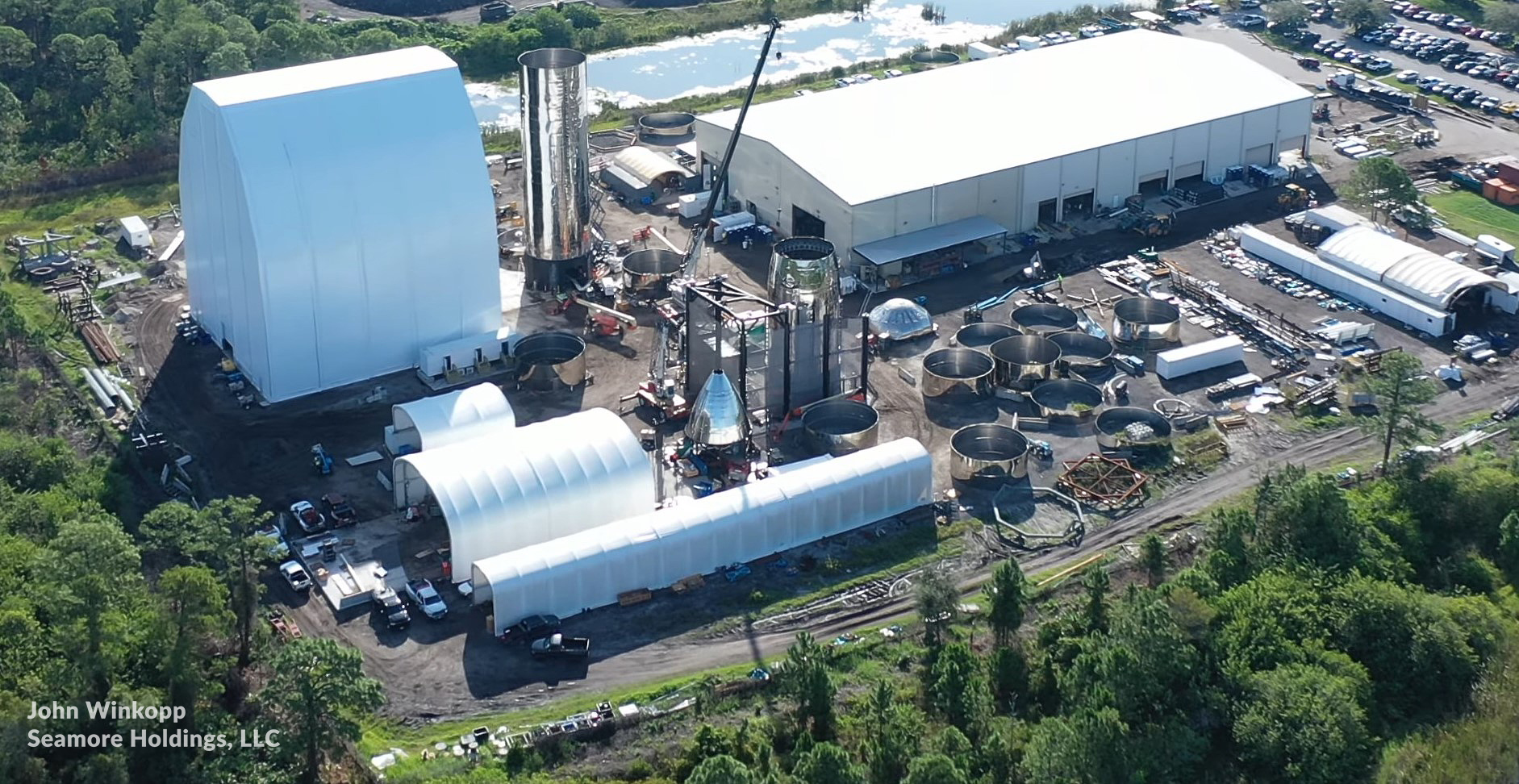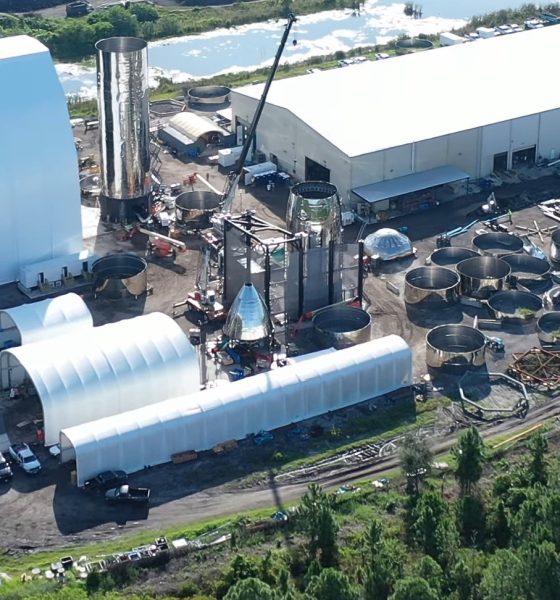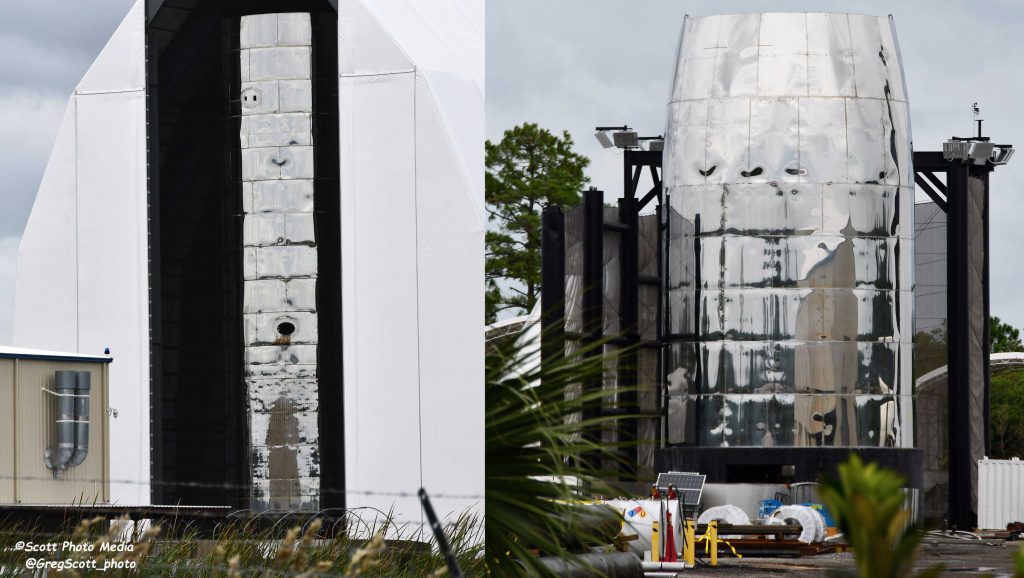

News
SpaceX scraps Florida Starship Mk2 prototype
SpaceX has scrapped the lone Starship prototype built in Florida in 2019, surprising very few.
Beginning a few months after work began on Starship Mk1 at SpaceX’s South Texas production facilities, a separate team in Cocoa, Florida was tasked with building a similar Starship Mk2 prototype. Not much is known about Mk2 relative to its much more publicized sibling but unofficial photos and videos taken over the course of 2019 suggested that SpaceX had effectively completed most of Starship Mk2 by the end of last year. However, built dozens of miles and several waterways away from a practical test facility, actually testing a Starship prototype assembled at SpaceX’s Cocoa facilities was always going to be an uphill battle.
To warrant the cost and effort that would be required to transport something as large as a vertical Starship from Cocoa, Florida to Cape Canaveral, Mk2 would have to be able offer something invaluable during testing. Now eight months after Starship Mk1 was destroyed during one of its first real tests, that was sadly not the case and SpaceX has chosen the simplest route forward – scrapping Mk2 where it sits.

In November 2019, SpaceX installed Starship Mk1 on a test stand in Boca Chica, Texas and began a series of tests. The ship passed an initial ambient temperature pressure test on the 18th but failed spectacularly during its first cryogenic proof test, said by SpaceX to have “pressurize[d] systems to the max.” Excluding Starhopper, Starship Mk1 was about as rough of a prototype as SpaceX could have feasibly built and the fact that it survived any length of time under cryogenic loads and pressures was fairly impressive.
Welded together almost entirely out in elements on the South Texas Gulf coast, the total success of Starship Mk1 (and its similar Mk2 sibling) would have flown in the face of almost every single tenet of modern aerospace production. As noted in a Teslarati article describing the Starship’s demise, the Mk1 production apparatus left plenty of room for improvement.
“[Videos of the failure implicated] the weld connecting the LOX dome to the cylindrical body of Starship’s LOX tank, pointing to a bad weld joint as the likeliest source of the failure. Although that hardware failure is unfortunate, Mk1’s loss will hopefully guide improvements in Starship’s design and manufacturing procedures.”
Teslarati.com — November 20th, 2019
That is precisely what SpaceX did – and was likely already doing – in response to Mk1’s failure. Just two months later, SpaceX successfully tested a steel Starship tank built in upgraded facilities with upgraded methods and reached pressures of 7.1 bar (~103 psi) before failing – likely a 50% improvement or better relative to Mk1. A second tank completed weeks later in late January 2020 reached 7.5 bar, sprung a leak, was repaired, and ultimately soared to 8.5 bar (~125 psi) before failing. Per CEO Elon Musk, that would technically be enough for a Starship to launch humans into orbit with an industry-standard ~40% safety factor.
Finally, SpaceX recently proved that a full-scale, two-tank Starship prototype built with the same methods and facilities as those test tanks could achieve the same results, completing a ~7.5 bar (~110 psi) cryogenic proof test with Starship SN4 on May 10th.
Long story short, the methods SpaceX used to build Starship Mk1 and Mk2 were already proven redundant more than six months ago and buried even deeper in May 2020. Aside from serving as a museum piece, Starship Mk2’s fate was sealed – the only real question was how and when it would be scrapped. For now, SpaceX’s Starship program will be almost exclusively stationed in South Texas, where it appears to be in good hands. Starship SN5 is currently expected to attempt its first wet dress rehearsal (WDR) and static fire tests no earlier than July 17th (today) at 8 am CDT (13:00 UTC).
Check out Teslarati’s Marketplace! We offer Tesla accessories, including for the Tesla Cybertruck and Tesla Model 3.

Investor's Corner
Tesla stock closes at all-time high on heels of Robotaxi progress

Tesla stock (NASDAQ: TSLA) closed at an all-time high on Tuesday, jumping over 3 percent during the day and finishing at $489.88.
The price beats the previous record close, which was $479.86.
Shares have had a crazy year, dipping more than 40 percent from the start of the year. The stock then started to recover once again around late April, when its price started to climb back up from the low $200 level.
This week, Tesla started to climb toward its highest levels ever, as it was revealed on Sunday that the company was testing driverless Robotaxis in Austin. The spike in value pushed the company’s valuation to $1.63 trillion.
Tesla Robotaxi goes driverless as Musk confirms Safety Monitor removal testing
It is the seventh-most valuable company on the market currently, trailing Nvidia, Apple, Alphabet (Google), Microsoft, Amazon, and Meta.
Shares closed up $14.57 today, up over 3 percent.
The stock has gone through a lot this year, as previously mentioned. Shares tumbled in Q1 due to CEO Elon Musk’s involvement with the Department of Government Efficiency (DOGE), which pulled his attention away from his companies and left a major overhang on their valuations.
However, things started to rebound halfway through the year, and as the government started to phase out the $7,500 tax credit, demand spiked as consumers tried to take advantage of it.
Q3 deliveries were the highest in company history, and Tesla responded to the loss of the tax credit with the launch of the Model 3 and Model Y Standard.
Additionally, analysts have announced high expectations this week for the company on Wall Street as Robotaxi continues to be the focus. With autonomy within Tesla’s sights, things are moving in the direction of Robotaxi being a major catalyst for growth on the Street in the coming year.
Elon Musk
Tesla needs to come through on this one Robotaxi metric, analyst says
“We think the key focus from here will be how fast Tesla can scale driverless operations (including if Tesla’s approach to software/hardware allows it to scale significantly faster than competitors, as the company has argued), and on profitability.”

Tesla needs to come through on this one Robotaxi metric, Mark Delaney of Goldman Sachs says.
Tesla is in the process of rolling out its Robotaxi platform to areas outside of Austin and the California Bay Area. It has plans to launch in five additional cities, including Houston, Dallas, Miami, Las Vegas, and Phoenix.
However, the company’s expansion is not what the focus needs to be, according to Delaney. It’s the speed of deployment.
The analyst said:
“We think the key focus from here will be how fast Tesla can scale driverless operations (including if Tesla’s approach to software/hardware allows it to scale significantly faster than competitors, as the company has argued), and on profitability.”
Profitability will come as the Robotaxi fleet expands. Making that money will be dependent on when Tesla can initiate rides in more areas, giving more customers access to the program.
There are some additional things that the company needs to make happen ahead of the major Robotaxi expansion, one of those things is launching driverless rides in Austin, the first city in which it launched the program.
This week, Tesla started testing driverless Robotaxi rides in Austin, as two different Model Y units were spotted with no occupants, a huge step in the company’s plans for the ride-sharing platform.
Tesla Robotaxi goes driverless as Musk confirms Safety Monitor removal testing
CEO Elon Musk has been hoping to remove Safety Monitors from Robotaxis in Austin for several months, first mentioning the plan to have them out by the end of 2025 in September. He confirmed on Sunday that Tesla had officially removed vehicle occupants and started testing truly unsupervised rides.
Although Safety Monitors in Austin have been sitting in the passenger’s seat, they have still had the ability to override things in case of an emergency. After all, the ultimate goal was safety and avoiding any accidents or injuries.
Goldman Sachs reiterated its ‘Neutral’ rating and its $400 price target. Delaney said, “Tesla is making progress with its autonomous technology,” and recent developments make it evident that this is true.
Investor's Corner
Tesla gets bold Robotaxi prediction from Wall Street firm
Last week, Andrew Percoco took over Tesla analysis for Morgan Stanley from Adam Jonas, who covered the stock for years. Percoco seems to be less optimistic and bullish on Tesla shares, while still being fair and balanced in his analysis.

Tesla (NASDAQ: TSLA) received a bold Robotaxi prediction from Morgan Stanley, which anticipates a dramatic increase in the size of the company’s autonomous ride-hailing suite in the coming years.
Last week, Andrew Percoco took over Tesla analysis for Morgan Stanley from Adam Jonas, who covered the stock for years. Percoco seems to be less optimistic and bullish on Tesla shares, while still being fair and balanced in his analysis.
Percoco dug into the Robotaxi fleet and its expansion in the coming years in his latest note, released on Tuesday. The firm expects Tesla to increase the Robotaxi fleet size to 1,000 vehicles in 2026. However, that’s small-scale compared to what they expect from Tesla in a decade.
Tesla expands Robotaxi app access once again, this time on a global scale
By 2035, Morgan Stanley believes there will be one million Robotaxis on the road across multiple cities, a major jump and a considerable fleet size. We assume this means the fleet of vehicles Tesla will operate internally, and not including passenger-owned vehicles that could be added through software updates.
He also listed three specific catalysts that investors should pay attention to, as these will represent the company being on track to achieve its Robotaxi dreams:
- Opening Robotaxi to the public without a Safety Monitor. Timing is unclear, but it appears that Tesla is getting closer by the day.
- Improvement in safety metrics without the Safety Monitor. Tesla’s ability to improve its safety metrics as it scales miles driven without the Safety Monitor is imperative as it looks to scale in new states and cities in 2026.
- Cybercab start of production, targeted for April 2026. Tesla’s Cybercab is a purpose-built vehicle (no steering wheel or pedals, only two seats) that is expected to be produced through its state-of-the-art unboxed manufacturing process, offering further cost reductions and thus accelerating adoption over time.
Robotaxi stands to be one of Tesla’s most significant revenue contributors, especially as the company plans to continue expanding its ride-hailing service across the world in the coming years.
Its current deployment strategy is controlled and conservative to avoid any drastic and potentially program-ruining incidents.
So far, the program, which is active in Austin and the California Bay Area, has been widely successful.








